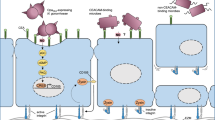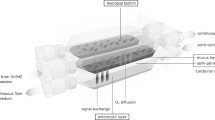Abstract
Diffusive Molecular Communication (DMC), is the most common approach employed in analysis and replication of different types of communication systems existing in nature. Exchange of Molecular Information (MI) using Bacterium, which is based on DMC and may be termed as Bacterial Communication (BC), is being used to model detection and cure processes of various decreases due to the Bacteria. DMC is being developed to serve almost each and every aspect of humanity. Also, various approaches to detect and cure the Bacterial disease are proposed in literature. It is noticeable that the complete Human Gut Track (HGT) is responsible to grade the severity of the disease. And therefore, literature presents the propagation of Bacteria in the HGT. Further, it is most important to mention that the impulse response of the system which characterizes bacteria propagation per unit area (f(y)) plays a major role in modeling viral transmission over the (HGT). In this work we analyzed bacterial concentration (N(y)) at different time points (t = 0.3, 0.5, 0.7, 0.9, 1.2). Our findings show that as time (t) increases, N(y) also increases. Additionally, we examined bacterial distribution (V(y)) for varying values of v (λ = 0.2, 0.3, 0.4, 0.6, 0.8). Results indicate that as v increases, V(y) decreases due to fixed distance, where mucus influences bacterial concentration. Increasing mucus flow rate for a fixed distance results in a decrease in Bacteria distribution. In particular we provided analytical expressions of Bacterial concentration (N(y)) and Bacterial distribution (V(y)) under certain impulse responses. Also, the effect of different physical parameters on (N(y)) and (V(y)) have been quantified with the help of numerical simulation. Presented analysis shows perfect agreement with the theoretical background.





Similar content being viewed by others
References
Chude-Okonkwo UA, Malekian R, Maharaj BT, Chude C (2015) Bio-inspired approach for eliminating redundant nanodevices in the internet of bio-nano things. In: 2015 IEEE Globecom Workshops (GC Wkshps), p 1–6
Akyildiz IF, Brunetti F, Blázquez C (2008) Nanonetworks: a new communication paradigm. Comput Netw 52(12):2260–2279
Singh SP, Yadav S, Singh RK, Kansal V, Singh G (2022) Secrecy capacity of diffusive molecular communication under different deployments. IEEE Access 10:21670–21683
Mishra S, Thakur P, Singh SP, Singh G (2023) Impairment modeling of diffusive molecular communication system: The vision, potential and challenges. In: AIP Conference Proceedings
Singh SP, Dwivedi VK, Singh G (2022) Multimedia nano communication for healthcare–noise analysis. In: Internet of Multimedia Things (IoMT). Academic Press. 2495, No. 1). AIP Publishing, pp 99–132
Singh D, Singh BK, Behera AK (2023) A hybrid bioinspired model for improving the efficiency of correlative auscultation analysis. Int J Inf Tecnol 15:3605–3611. https://doi.org/10.1007/s41870-023-01429-x
Agrawal S, Sahu SP (2023) Image-based Parkinson disease detection using deep transfer learning and optimization algorithms. Int J Inf Tecnol. https://doi.org/10.1007/s41870-023-01601-3
Ferrari M, Vakilipoor F, Regonesi E, Rapisarda M, Magarini M (2022) Channel characterization of diffusion-based molecular communication with multiple fully-absorbing receivers. IEEE Trans Commun 70(5):3006–3019
Kantelis K, Papadimitriou G, Nikopolitidis P, Kavakiotis I, Tsave O, Salifoglou A (2017) Fick’s law model revisited: A new approach to modeling multiple sources message dissemination in bacterial communication nanosystems. IEEE Trans Mol Biol MultiScale Commun 3(2):89–105
Felicetti L, Femminella M, Reali G, Liò P (2016) Applications of molecular communications to medicine: a survey. Nano Commun Netw 7:27–45
Singh RK, Singh SP, Tiwari S (2020) Performance evaluation of wireless nanosensor networks under interference. Nano Commun Netw 25:100311
Singh RK, Singh SP, Tiwari S (2021) Performance of electromagnetic nanonetworks under relaying for plant monitoring. Phys Commun 47:101316
Zoofaghari M, Arjmandi H (2018) Diffusive molecular communication in biological cylindrical environment. IEEE Trans Nanobiosci 18(1):74–83
Phillips ZN, Husna AU, Jennings MP, Seib KL, Atack JM (2019) Phasevarions of bacterial pathogens–phase-variable epigenetic regulators evolving from restriction–modification systems. Microbiology 165(9):917–928
Pawar V, Sachdeva S (2023) ParallelChain: a scalable healthcare framework with low‐energy consumption using blockchain. International Transactions in Operational Research. https://doi.org/10.1111/itor.13278
Vrancken G, Gregory AC, Huys GR, Faust K, Raes J (2019) Synthetic ecology of the human gut microbiota. Nat Rev Microbiol 17(12):754–763
Zhu B, Wang X, Li L (2010) Human gut microbiome: the second genome of the human body. Protein Cell 1(8):718–725
Bi D, Almpanis A, Noel A, Deng Y, Schober R (2021) A survey of molecular communication in cell biology: establishing a new hierarchy for interdisciplinary applications. IEEE Commun Surv Tutor 23(3):1494–1545. https://doi.org/10.1109/COMST.2021.3066117
Gulec F, Atakan B (2021) A molecular communication perspective on airborne pathogen transmission and reception via droplets generated by coughing and sneezing. IEEE Trans Mol Biol MultiScale Commun 7(3):175–184. https://doi.org/10.1109/TMBMC.2021.3083723
Singh SP, Dwivedi VK, Singh G (2022) Multimedia nano communication for healthcare: Noise analysis. In: Internet of Multimedia Things (IoMT). Academic Press, p 99–132
Trinh DP, Jeong Y, Shin H, Win MZ (2020) Molecular communication in H-diffusion. IEEE Trans Commun 68(7):4293–4310
Koca C, Civas M, Sahin SM, Ergonul O, Akan OB (2021) Molecular communication theoretical modeling and analysis of SARS-CoV2 transmission in the human respiratory system. IEEE Trans Mol Biol MultiScale Commun 7(3):153–164
Gursoy MC, Nasiri-Kenari M, Mitra U (2022) Towards high data-rate diffusive molecular communications: a review on performance enhancement strategies. Digit Signal Process 124:103161
Lotter S, Brand L, Jamali V, Schäfer M, Loos HM, Unterweger H, Schober R (2023) Experimental Research in Synthetic Molecular Communications--Part II: Long-Range Communication. arXiv preprint arXiv:2301.06424.
Qiu S, Haselmayr W, Li B, Zhao C, Guo W (2017) Bacterial relay for energy-efficient molecular communications. IEEE Trans Nanobiosci 16(7):555–562
Arjmandi H, Zoofaghari M, Noel A (2019) Diffusive molecular communication in a biological spherical environment with partially absorbing boundary. IEEE Trans Commun 67(10):6858–6867
Yamin M (2020) Counting the cost of COVID-19. Int J Inf Tecnol 12:311–317. https://doi.org/10.1007/s41870-020-00466-0
Roy SK, Sharan P (2020) Design of ultra-high sensitive biosensor to detect E. Coli in water. Int J Inf Tecnol 12:775–780. https://doi.org/10.1007/s41870-019-00327-5
Eswara Rao GV, Rajitha B (2024) HQF-CC: hybrid framework for automated respiratory disease detection based on quantum feature extractor and custom classifier model using chest X-rays. Int J Inf Tecnol. https://doi.org/10.1007/s41870-023-01681-1
Author information
Authors and Affiliations
Corresponding author
Ethics declarations
Conflict of interest
The authors have no relevant financial or non-financial interests to disclose. The authors have no competing interests to declare that are relevant to the content of this article.
Consent to publication
We confirm that this work is original and has not been published elsewhere, nor it is currently under consideration for publication elsewhere. We believe that this manuscript is appropriate for publication by this journal.
Rights and permissions
Springer Nature or its licensor (e.g. a society or other partner) holds exclusive rights to this article under a publishing agreement with the author(s) or other rightsholder(s); author self-archiving of the accepted manuscript version of this article is solely governed by the terms of such publishing agreement and applicable law.
About this article
Cite this article
Asim, M., Jaiswal, R., Chugh, U. et al. Diffusive molecular communication for bacterium propagation over human gut track. Int. j. inf. tecnol. (2024). https://doi.org/10.1007/s41870-024-01841-x
Received:
Accepted:
Published:
DOI: https://doi.org/10.1007/s41870-024-01841-x




